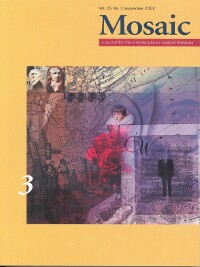Issue 35.3
Overview

General Issue
Published: September 2002
View the issue introduction or see the issue summary and contents below.
10 essays, totalling 192 pages
$15.00 CAD
This general issue of Mosaic contains ten essays, most of which focus on images, biography, colonialism, and the body. It opens with an essay by W.J.T. Mitchell, who examines the agency of images in social conflicts. Other essays included in the issue examine Fritz Lang’s Rancho Notorious as an allegory, Jean-François Lyotard’s postmodern biography of André Malraux, early modern advertisings of Pocahontas’s marriage, and the female body in Kate Chopin’s The Awakening.
The Surplus Value of ImagesW.J.T. Mitchell This essay analyzes the ways in which images are over- and underestimated, from idols that signify the highest values and demand human sacrifice, to empty signs that are worthless, hollow illusions. It then shows how these disparate estimations of “the surplus value of images” lead to the perception of images as living agencies that play crucial roles in social conflicts. | |
Rewriting Allegory with a Vengeance: Textual Strategies in Fritz Lang’s Rancho NotoriousFlorianne Wild Fritz Lang’s Western Rancho Notorious is proposed as allegory, not in the literary-historical mode, but as an attitude or perception occurring when one text is seen to double another. This essay pursues the idea of film as rebus, as a narrative “other,” allowing us to see beyond the traditional or modernist view, which is antithetical to allegory. | |
Lyotard’s Mosaic Art of BiographyRoland A. Champagne Jean-François Lyotard’s biography of André Malraux is the coincidence of the desires of two artists in a single mosaic. This mosaic melds the arts of film, theatre, painting, and sculpture to provide semiotic frameworks for organizing what is identified as “postmodern biography.” | |
Red Cannas, Sardine Cans, and the Gaze of the ObjectPeter Schwenger Lacan’s assertion in Seminar XI, “things look at me,” leads him to painting, where the canvas enacts the dynamics of the screen. This essay analyzes these dynamics in Georgia O’Keeffe’s Red Cannas. There the object becomes an alien “thing”; the subject becomes another kind of Thing, the equally alien Freudian complex. Between these two things shuttles, interminably, the gaze. | |
Writing Lives, Writing Lies: The Pursuit of Apocryphal BiographiesAlejandro Herrero-Olaizola Steven Millhauser’s Edwin Mullhouse: The Life and Death of an American Writer, 1943-1954, by Jeffrey Cartwright, and Augusto Monterroso’s Lodemás es silencio: La vida y la obra de Eduardo Torres underscore in a Borgesian fashion the fictionality and incompleteness of biographical discourse. In their works, parodic and apocryphal writings revise the relationship between the biographer and the biographee, and pose the question of whether it is really possible to write someone’s life. | |
“He Never Harmed an Indian”: Ethnographic Consequences of Alexander Mackenzie’s Heroic NarrativeKathleen Venema This close reading of grammatical and narrative forms in Alexander Mackenzie’s Voyages from Montreal extends the tradition of colonial discourse analysis to include linguistic analysis. The examination shows how the text’s paradigm of heroic crisis resolution is supported by strategic manipulations of narrative elements to produce potently racist ethnography. | |
“Strange Wives”: Pocahontas in Early Modern Colonial AdvertisementDavid Stymeist This essay examines the Virginia Company’s advertisement of the marriage between Pocahontas and John Rolfe, an English settler. The symbolic promotion of Anglo-Indian intermarriage served as a substitute for actual miscegenation as a colonial practice and concealed the reality of open hostility, xenophobia, and endogamy in the Virginia colony. | |
Fashioning the Hybrid Woman in Kate Chopin’s The AwakeningCarolyn L. Mathews This essay brings American social history, costume history, and fashion theory to bear on Kate Chopin’s 1899 novel The Awakening. By matching Chopin’s descriptions of dress against those in contemporaneous women’s magazines, etiquette manuals, and discourse on dress reform, this essay analyzes Chopin’s use of fashion and the bared body in her representation of the female subject. | |
Plotting Political Personhood: Literary Self-Making and Contract-BreakingJennifer Gillan Contract theory excludes women and people of colour because it does not take into account the effect of specific bodily difference in its supposition that the abstract individual is a free contractor who owns the “property in his person.” Edith Wharton’s The House of Mirth and John Guare’s Six Degrees of Separation illustrate the effect of corporeality on contract. | |
Doing NothingTzachi Zamir This essay argues that by structuring specific patterns of response, a work of literature (Hamlet) can create an awareness that cannot be achieved through systematic philosophical presentation. The play’s extensive use of acoustic imagery is related to Hamlet’s delay, interpreted as a tension between the need to be disclosed and the desire to remain encapsulated. |